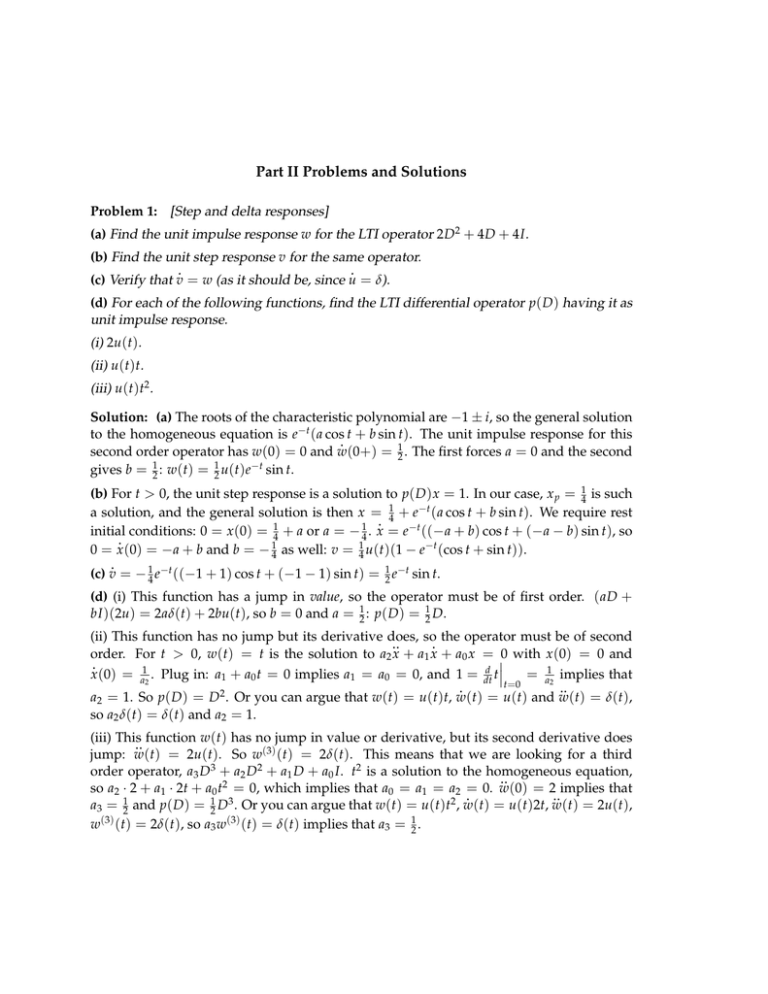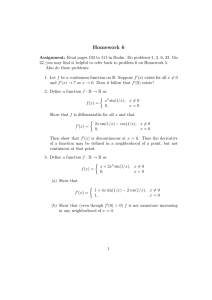Part +
advertisement

Part II Problems and Solutions Problem 1: [Step and delta responses] (a) Find the unit impulse response w for the LTI operator 2D2 + 4D + 4I. (b) Find the unit step response v for the same operator. . . (c) Verify that v = w (as it should be, since u = δ). (d) For each of the following functions, find the LTI differential operator p( D ) having it as unit impulse response. (i) 2u(t). (ii) u(t)t. (iii) u(t)t2 . Solution: (a) The roots of the characteristic polynomial are −1 ± i, so the general solution to the homogeneous equation is e−t ( a cos t + b sin t). The unit impulse response for this . second order operator has w(0) = 0 and w(0+) = 12 . The first forces a = 0 and the second gives b = 12 : w(t) = 12 u(t)e−t sin t. (b) For t > 0, the unit step response is a solution to p( D ) x = 1. In our case, x p = 14 is such a solution, and the general solution is then x = 14 + e−t ( a cos t + b sin t). We require rest . initial conditions: 0 = x (0) = 14 + a or a = − 14 . x = e−t ((− a + b) cos t + (− a − b) sin t), so . 0 = x (0) = − a + b and b = − 14 as well: v = 14 u(t)(1 − e−t (cos t + sin t)). . (c) v = − 14 e−t ((−1 + 1) cos t + (−1 − 1) sin t) = 12 e−t sin t. (d) (i) This function has a jump in value, so the operator must be of first order. ( aD + bI )(2u) = 2aδ(t) + 2bu(t), so b = 0 and a = 12 : p( D ) = 12 D. (ii) This function has no jump but its derivative does, so the operator must be of second .. . order. For t > 0, w(t) = t is the solution to a2 x + a1 x + a0 x = �0 with x (0) = 0 and . � x (0) = a12 . Plug in: a1 + a0 t = 0 implies a1 = a0 = 0, and 1 = dtd t� = a12 implies that . t =0 .. a2 = 1. So p( D ) = D2 . Or you can argue that w(t) = u(t)t, w(t) = u(t) and w(t) = δ(t), so a2 δ(t) = δ(t) and a2 = 1. (iii) This function w(t) has no jump in value or derivative, but its second derivative does .. jump: w(t) = 2u(t). So w(3) (t) = 2δ(t). This means that we are looking for a third order operator, a3 D3 + a2 D2 + a1 D + a0 I. t2 is a solution to the homogeneous equation, .. so a2 · 2 + a1 · 2t + a0 t2 = 0, which implies that a0 = a1 = a2 = 0. w(0) = 2 implies that . .. a3 = 12 and p( D ) = 12 D3 . Or you can argue that w(t) = u(t)t2 , w(t) = u(t)2t, w(t) = 2u(t), w(3) (t) = 2δ(t), so a3 w(3) (t) = δ(t) implies that a3 = 12 . MIT OpenCourseWare http://ocw.mit.edu 18.03SC Differential Equations�� Fall 2011 �� For information about citing these materials or our Terms of Use, visit: http://ocw.mit.edu/terms.






